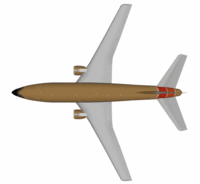Login
Our 3D CAD supplier models have been moved to 3Dfindit.com, the new visual search engine for 3D CAD, CAE & BIM models.
You can log in there with your existing account of this site.
The content remains free of charge.

Top Links
Knowledge Contributors
Search
Favorite Knowledge
Knowledge
Knowledge - 256 Items
Fuselage ( 10708 views )
Fuselage
Licensed under Creative Commons Attribution-Share Alike 3.0 (Anynobody).
The fuselage (; from the French fuselé "spindle-shaped") is an aircraft's main body section. It holds crew, passengers, and cargo. In single-engine aircraft it will usually contain an engine, as well, although in some amphibious aircraft the single engine is mounted on a pylon attached to the fuselage, which in turn is used as a floating hull. The fuselage also serves to position control and stabilization surfaces in specific relationships to lifting surfaces, which is required for aircraft stability and maneuverability.
Fusion energy gain factor ( 10413 views )
Fusion energy gain factor
The fusion energy gain factor, usually expressed with the symbol Q, is the ratio of fusion power produced in a nuclear fusion reactor to the power required to maintain the plasma in steady state. The condition of Q = 1, when the power being released by the fusion reactions is equal to the required heating power, is referred to as breakeven, or in some sources, scientific breakeven.
The power given off by the fusion reactions may be captured within the fuel, leading to self-heating. Most fusion reactions release at least some of their energy in a form that cannot be captured within the plasma, so a system at Q = 1 will cool without external heating. With typical fuels, self-heating in fusion reactors is not expected to match the external sources until at least Q = 5. If Q increases past this point, increasing self-heating eventually removes the need for external heating. At this point the reaction becomes self-sustaining, a condition called ignition. Ignition corresponds to infinite Q, and is generally regarded as highly desirable for a practical reactor design.
Over time, several related terms have entered the fusion lexicon. As a reactor does not cover its own heating losses until about Q = 5, the term engineering breakeven is sometimes used to describe a reactor that produces enough electricity to provide that heating. Above engineering breakeven a machine would produce more electricity than it uses, and could sell that excess. A machine that can sell enough electricity to cover its operating costs, estimated to require at least Q = 20, is sometimes known as economic breakeven. Additionally, fusion fuels, especially tritium, are very expensive, so many experiments run on various test gasses like hydrogen or deuterium. A reactor running on these fuels that reaches the conditions for breakeven if tritium was introduced is said to be operating at extrapolated breakeven.
As of 2017, the record for Q is held by the JET tokamak in the UK, at Q = (16 MW)/(24 MW) ≈ 0.67, first attained in 1997. ITER was originally designed to reach ignition, but is currently designed to reach Q = 10, producing 500 MW of fusion power from 50 MW of injected thermal power. The highest record for extrapolated breakeven was posted by the JT-60 device, with Qext = 1.25.
Fusion power ( 16413 views )
Fusion power
Licensed under Creative Commons Attribution-Share Alike 3.0 (EFDA JET).
Fusion power is a theoretical form of power generation in which energy will be generated by using nuclear fusion reactions to produce heat for electricity generation. In a fusion process, two lighter atomic nuclei combine to form a heavier nucleus, and at the same time, they release energy. This is the same process that powers stars like our Sun. Devices designed to harness this energy are known as fusion reactors.
Fusion processes require fuel and a highly confined environment with a high temperature and pressure, to create a plasma in which fusion can occur. In stars, the most common fuel is hydrogen, and gravity creates the high temperature and confinement needed for fusion. Fusion reactors generally use hydrogen isotopes such as deuterium and tritium, which react more easily, and create a confined plasma of millions of degrees using inertial methods (laser) or magnetic methods (tokamak and similar), although many other concepts have been attempted. The major challenges in realising fusion power are to engineer a system that can confine the plasma long enough at high enough temperature and density, for a long term reaction to occur, and for the most common reactions, managing neutrons that are released during the reaction, which over time can degrade many common materials used within the reaction chamber.
As a source of power, nuclear fusion is expected to have several theoretical advantages over fission. These include reduced radioactivity in operation and little nuclear waste, ample fuel supplies, and increased safety. However, controlled fusion has proven to be extremely difficult to produce in a practical and economical manner. Research into fusion reactors began in the 1940s, but to date, no design has produced more fusion power output than the electrical power input, therefore all existing designs have had a negative power balance.Over the years, fusion researchers have investigated various confinement concepts. The early emphasis was on three main systems: z-pinch, stellarator and magnetic mirror. The current leading designs are the tokamak and inertial confinement (ICF) by laser. Both designs are being built at very large scales, most notably the ITER tokamak in France, and the National Ignition Facility laser in the United States. Researchers are also studying other designs that may offer cheaper approaches. Among these alternatives there is increasing interest in magnetized target fusion and inertial electrostatic confinement.
Futaba Corporation ( 1491 views )
Futaba Corporation
Futaba Corporation (双葉電子工業株式会社, Futaba Denshi Kōgyō Kabushiki-gaisha) is a Japanese company founded in 1948, originally to produce vacuum tubes. As time passed, production and elemental techniques of the vacuum tube transformed into the manufacturing of vacuum fluorescent displays (VFDs), tool and die set components, radio control equipment and OLED displays.
Futon ( 7217 views )
Futon
Licensed under Creative Commons Attribution-Share Alike 2.0 (Christian Kadluba).
A futon (布団) is the Japanese traditional style of bedding.
A complete futon set consists of both a mattress (敷き布団, shikibuton, lit. "spreading futon") and a duvet (掛け布団, kakebuton, lit. "covering futon"). Both elements of a futon bedding set are pliable enough to be aired, folded and stored away in a large closet (oshiire) during the day allowing the room to serve for purposes other than as a bedroom. Traditionally, futon are used on tatami, a type of mat used as a flooring material which also provides a softer base for the futon than most harder flooring types, such as wood or stone. Futons must be folded away daily and aired in the sun regularly to prevent mold from developing and also to keep the futon free of mites (dani). All over Japan, futon can commonly be seen hanging over balconies airing in the sun. A futon dryer is also available for those unable to hang out their futon.
Western-style futons, which typically resemble low, wooden sofa beds, differ substantially from their Japanese counterparts. They often have the dimensions of a western mattress, and are too thick to fold 180°. They are often set up and stored on a slatted frame, which avoids having to move them to air them, especially in the dry indoor air of a centrally-heated house (Japanese homes were not traditionally centrally-heated).
Future Electronics ( 297 views )
Future Electronics
Future Electronics Inc. is a distributor of electronic and electro-mechanical components headquartered in Pointe-Claire, Quebec. Founded in 1968 by Canadian billionaire Robert Miller, the company is one of Quebec's largest privately owned companies and is currently the fourth largest electronics distributor in the world. It operates in 169 locations in 44 countries in the Americas, Europe, Asia and Africa.
In 2014 its revenues were $5 billion.














